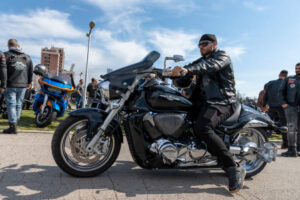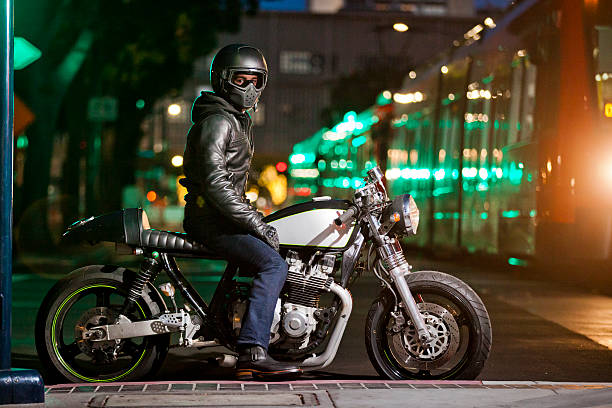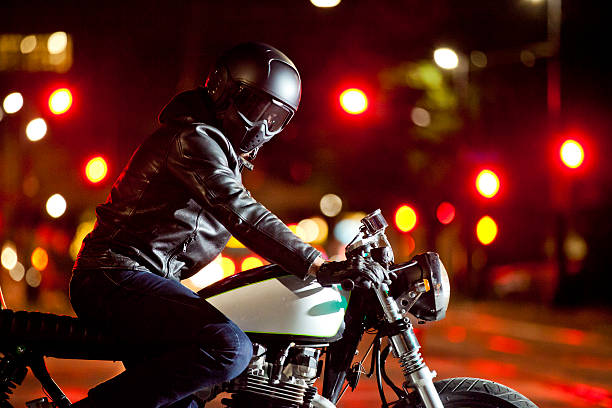Brothership Emblems: Biker Gang Vest Patches and Symbols
The biker gang vest is worn with pride and can provoke wonder and curiosity. These vests with patches and symbols have deeper meanings and narratives that echo throughout their wearers.

These clothing’ emblems, delicately embroidered onto leather, reveal their meaning. The club name is prominently displayed on the top rocker, usually arched over the vest back. This is more than branding—it shows a biker’s loyalty and claim. In contrast, the vest’s bottom rocker designates the area, declaring presence and dominance.
The club’s emblem or logo, a complex symbol that frequently represents the club’s values and culture, dominates the vest. The skull and crossbones and the Native American chief’s head are not only decorations but symbols of the club’s history and principles.
The 1940s-era “1%er” emblem is one of the most respected patches. It responds to the American Motorcyclist Association’s claim that 99% of motorcyclists are law-abiding, implying that outlaws proudly proclaim their 1% status. Only public outlaws wear this patch, symbolizing disobedience against society and law.
The “MC” patch, which certifies the club’s recognition by the coalition of outlaw motorcycle clubs, is also essential. This shows the club’s validity and sovereignty in the motorcycle community, not just administrative recognition.
Memorial patches are different. Wearing these in memory of fallen colleagues symbolizes respect and fraternity. These patches commemorate those who gave their last ride and show loyalty to their names or dates.
Rally or event patches also tell brotherhood and adventure stories. These patches record their adventures and experiences, from a challenging cross-country ride to a heartwarming local charity event.
When exploring vest adornments, one finds office title patches like “President,” “Vice President,” “Secretary,” and “Road Captain.” These practical patches indicate the wearer’s club duties. Through dedication and service to the club, they win trust and respect.
Personal patches like “First Aid,” which indicates medical training, are more individualized. Members who are being considered for full membership but have not yet been vested with the club’s colors wear patches like “Prospect.”
The details of these patches differ for each club. Some clubs have patches that indicate veteran status for specific wars or conflicts. Others wear patches indicating charitable or community work, showing a club’s involvement off the road.
The placement of patches might be traditional or modified to represent personal tastes or accomplishments, adding complexity to an already complicated vestment. This customization makes the vest and rider stand out in the community.
These garments and their composite symbolism typically divide public opinion. To some, they represent rebellion and a dangerous subculture; to others, they reflect a rich culture of companionship and freedom that biking represents. These patches enable the person and the club to define themselves through this paradox.
To those who know, the biker gang vest is a statement of identity, belief, and camaraderie, not just an accessory. Each patch is a narrative, memory, responsibility, or homage woven into a tapestry as complicated as the wearers’ lives. The vest is lived in, signifying a unique lifestyle that is revered, loathed, misunderstood, and celebrated.

Thus, a biker’s vest’s elaborate patchwork is beautiful and essential to society’s complicated conversation between subcultures. Each patch acquired, applied, and exhibited symbolizes the biker community’s delicate balance between individualism and brotherhood.Preserving the Past: Biker Gang Vest Maintenance
The biker gang vest symbolizes a rider’s dedication and experiences. Proper vest care is crucial to keeping it looking nice and surviving years of riding, weather, and lifestyle wear and tear.
Many motorcycle vests are made of leather, a robust but flexible material that lasts if maintained. First, you must know the sort of leather your vest is made of to determine the proper care and products. Cowhide, buffalo hide, and lambskin require different upkeep.
Leather vests need regular cleaning to prevent deterioration and degradation. Use a gentle brush or moist cloth to remove surface dirt and debris. Oversaturating leather can cause stiffness and cracking as it dries. Use a leather cleaner for a deeper clean, especially if the vest needs to be addressed. Apply the cleaner with a soft cloth in a circular motion, being careful not to use too much, which might leave residues.
Leather must be moisturized like skin to be pliable and prevent fractures. Apply a good leather conditioner when the leather is moist after cleaning. Rub the conditioner evenly in all crevices, especially seams and near stitching, where leather dries faster. Buff any extra conditioner with a smooth, dry rag once the vest absorbs it.
Keep motorcycle vests with metal studs or other hardware rust—and tarnish-free. Use a soft cloth to apply chrome, stainless steel, or brass polish. Rust may stain and weaken leather; thus, this keeps the hardware shiny and avoids leather degeneration.
Vest storage matters, too. When not in use, hang your leather vest on a broad, padded hanger for smooth shoulders and no creases. Instead of plastic coverings, choose breathable fabric covers to prevent dust and mildew. Keep leather cool and dry away from direct sunlight and heat sources, which can fade or damage it.
Tears or worn patches may require vest repair in addition to primary care. Minor tears can be repaired with a leather kit. Filling tears or holes with a vest-colored compound is typical of these kits. For extensive repairs, a professional leather repair service may help preserve the vest’s beauty.

Biker vests typically have custom patches sewn on to commemorate events or membership. When adding patches, consider vest balance and design. Professional patch sewing is recommended since thick leather is rugged to stitch without the correct equipment. This secures patches and prevents leather rips during rides.
Waterproofing is essential for bikers in different weather conditions. Water can stiffen and crack the leather. Use a leather-compatible waterproofing spray to prevent dampness. This spray should be used occasionally, especially before the wet season, to protect the vest from rain.
Last, the vest’s patches’ colors and artwork must be preserved, as well as its physical condition. Do not use chemical cleaners near logos or colored patches. Often, a moist cloth wipe will clean these ornamented sections without fading.
Your biker gang vest can represent your travels, memories, and rider identity with proper care. This upkeep keeps the vest looking excellent and protects its memories, making it a heritage piece that can be worn for years or generations. Maintaining a biker vest should be as distinctive as the rider’s road. From frequent cleaning to careful storage, each action keeps the vest ready for the trip.





Leave a Reply